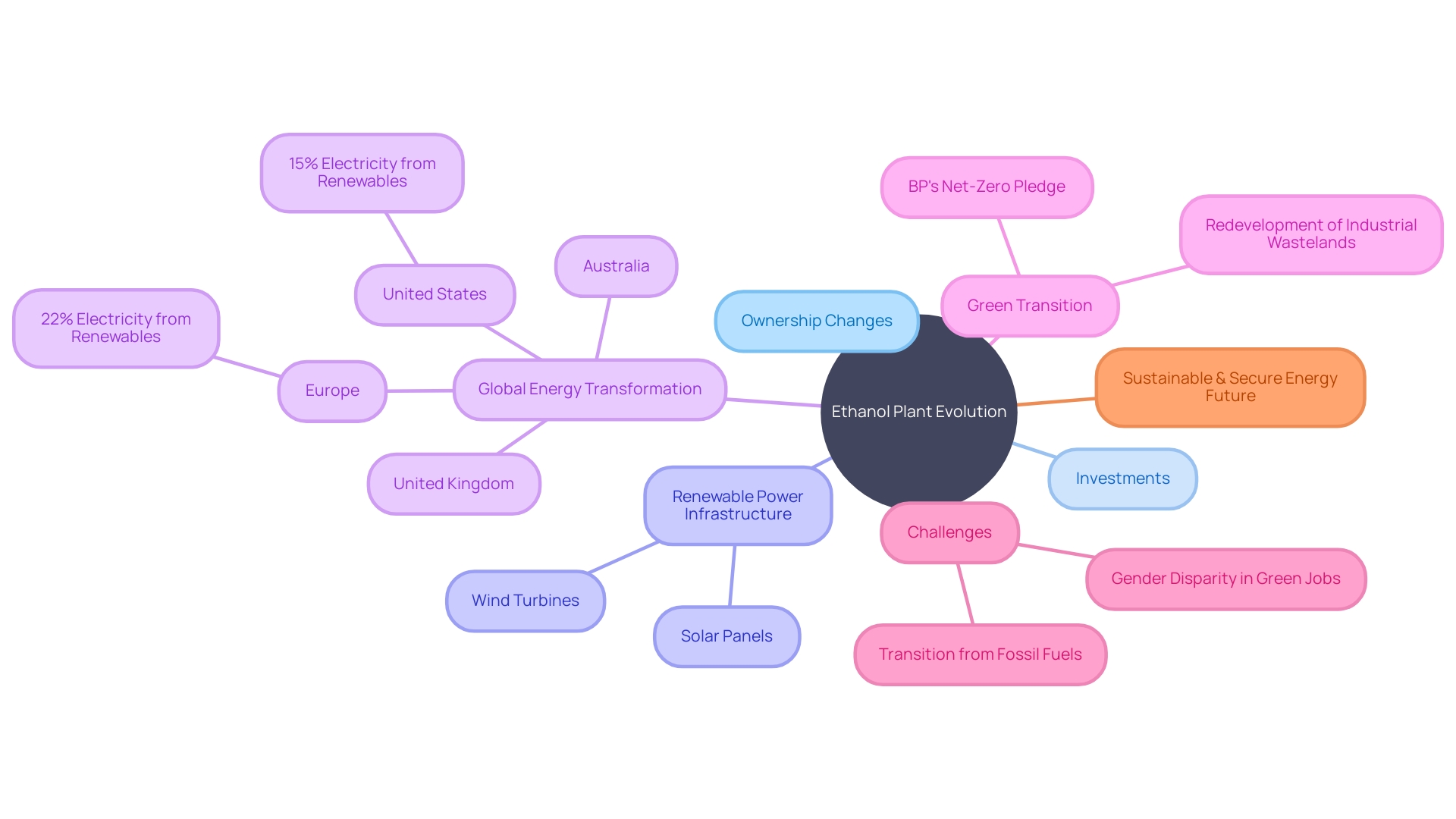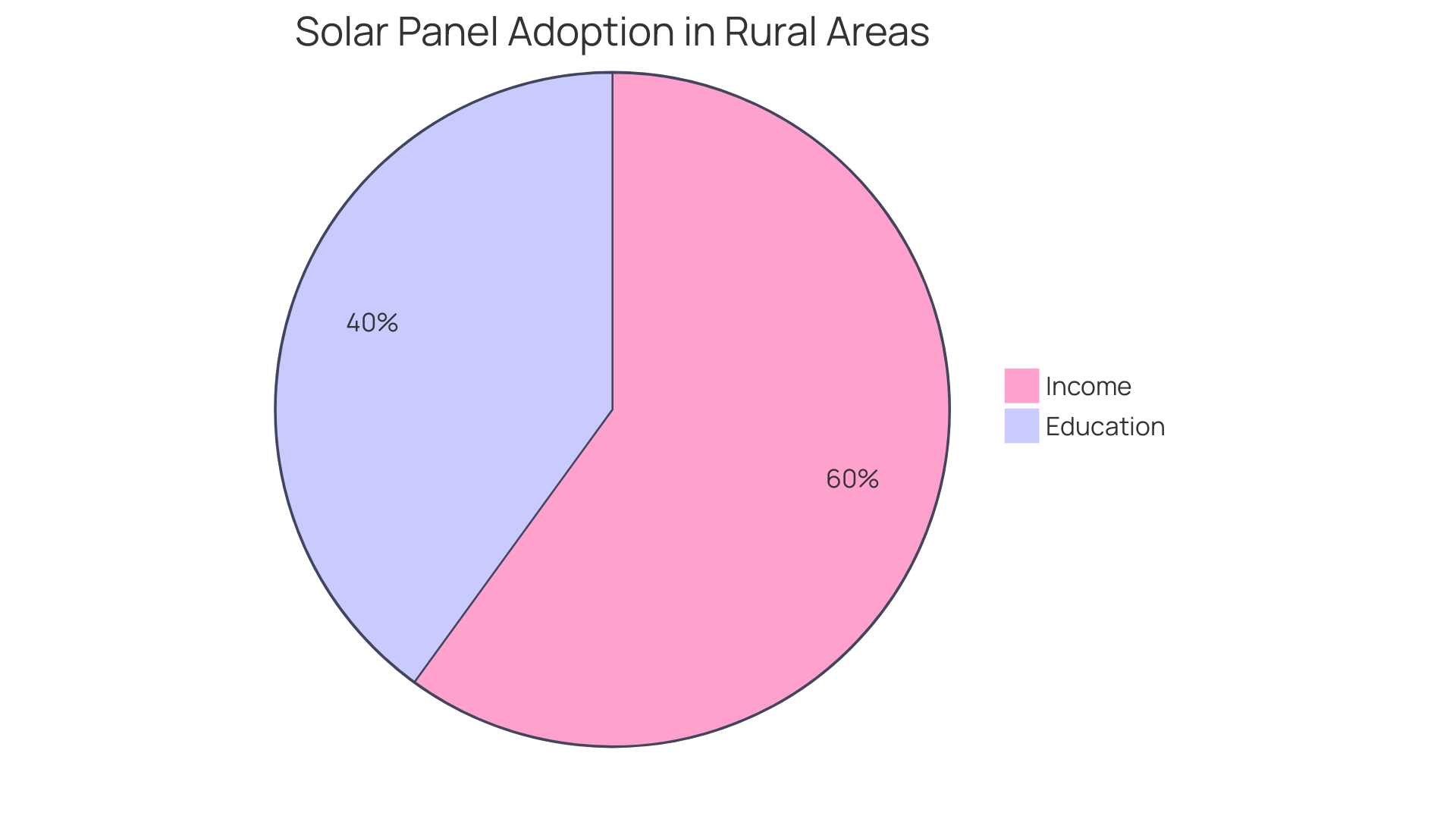Introduction
The Bluffton Ethanol Plant in Bluffton, Indiana, is a testament to the advancements in sustainable energy practices and the commitment to renewable fuels. With a focus on driving technological innovation for a cleaner, greener future, the plant exemplifies the ethos of Battelle, an organization dedicated to scientific innovation. The biofuels industry, including facilities like the Bluffton Ethanol Plant, plays a crucial role in the shift towards a bio-based economy, supported by over two decades of evidence showcasing ethanol as a viable alternative to fossil fuels.
Advocacy from organizations like the Climate Ethanol Alliance further emphasizes the importance of ethanol in sustainable solutions. The plant's embrace of green building standards and sustainable practices contributes to a range of benefits, including reduced resource depletion and a minimized impact on human health and the environment. As the world grapples with climate change, the Bluffton Ethanol Plant serves as a leading example of sustainable practices within the biofuels industry, driving the global dialogue on renewable energy and sustainability.
Overview of the Bluffton Ethanol Plant
The Ethanol Plant in Bluffton, Indiana, stands as proof of the advancement of sustainable practices in power generation. This plant not only exemplifies the strides made in renewable energy but also echoes the ethos of Battelle, an organization dedicated to pushing the boundaries of scientific innovation for societal and economic benefit. With a history of more than 90 years in advancing technology, Battelle's dedication to science and education aligns with the values of the facility, which is contributing to a cleaner, greener future.
In the broader context, the biofuels industry, including facilities like the Bluffton Ethanol Plant, has been at the forefront of the shift towards a bio-based economy. This evolution is underpinned by over two decades of real-world evidence supporting ethanol as a viable alternative to traditional fossil fuels. Such facilities are essential in driving technological innovation that benefits climate, rural development, and air quality, while also enhancing independence in terms of power.
The Climate Ethanol Alliance, a collective including names like Pannonia Bio and the Renewable Fuels Association, champions the cause of renewable ethanol. Their advocacy for evidence-based policymaking in transport decarbonisation underscores the role of ethanol in sustainable solutions. This is especially pertinent as the world continues to grapple with climate change and reassess the role of various energy sources.
Green building standards like LEED, which have seen over 167,000 accredited constructions, are indicative of the sustainability mindset that is now increasingly prevalent across industries, including biofuel production. The Bluffton plant, in embracing these sustainable practices, contributes to the cascading benefits of green construction, such as reduced resource depletion and minimized impact on human health and the environment.
The trajectory of biofuels is further strengthened by insights from ExxonMobil Low Carbon Solutions, which provide a suite of solutions for emission reductions across various industrial sectors. This reflects a broader movement towards innovative and scalable solutions that can facilitate the transition to net-zero emissions without disrupting current operations.
Adding to the credibility of bio-based diesel, which includes biodiesel and renewable diesel, experts highlight the majority of its production comes from vegetable oils, commonly found in everyday cooking oil. This fact, along with the maturity of production technologies, positions bio-based diesel as a sustainable choice for sectors like heavy transport and fields, which are challenging to decarbonize.
Data-driven approaches, as evidenced by the innovative carbon calculation tool Carbonica, enable precise measurement and management of carbon emissions across the lifecycle of buildings and operations. Such tools underscore the commitment to environmental stewardship and are emblematic of the responsible business practices that the plant embodies.
Together, these aspects portray a picture of the Ethanol Plant as a prominent model of sustainable practices within the biofuels industry, which are crucial for the long-term well-being of our planet and society. The plant's operations not only meet the immediate needs of the region but also contribute to the global conversation on sustainability.
History and Ownership Transition
Since its establishment in 2007, the Ethanol Plant in Bluffton has undergone significant changes, reflecting broader shifts in the power sector. Initially brought to life by local investors passionate about the promise of sustainable fuels, the journey of a certain place reflects a global narrative of energy transformation. With each change in ownership, the facility has seen significant investments that have expanded its capabilities and output, echoing industry-wide advancements in renewable power infrastructure.
This evolution is not unique to Bluffton. For example, VARO, operating throughout Europe, highlights the significance of cultivating a diverse range of power sources and acknowledges the need for transformation in the sector through the collaborative endeavors of individuals who have a shared vision for a sustainable future. Likewise, the shift from coal to diesel in Longyearbyen, Svalbard, and ultimately to sustainable power sources, highlights the worldwide necessity for reliable and enduring solutions that are in line with climate objectives.
In the broader perspective, BP's pledge to achieve net-zero by 2050 and the growing focus on the environmental impact of sectors such as shipping, underscore the importance of green transitions. The sector, encompassing the biofuels field, is experiencing a surge in investments and innovations, like the redevelopment of industrial wastelands in Bordeaux into new ventures, illustrating the dynamic nature of supply chains and the repurposing of legacy infrastructures for future needs.
As sustainable power sources turn out to be progressively incorporated into the network, the responsibility lies on administrators to oversee their sporadic nature and ensure a consistent power supply. The sector's expansion also presents challenges, as highlighted by the gender disparity in green jobs and the complexities of transitioning away from fossil fuels in regions heavily dependent on them.
The narrative of the Ethanol Plant located in Bluffton exemplifies the overall patterns and challenges within the sustainable and secure future of low-carbon energy, showcasing the transition towards value chains of low-carbon energy and the collaborative effort required to achieve it.

Ethanol Production Process: Dry Milling
The Bluffton Ethanol Plant showcases a stellar example of innovation in renewable power with its state-of-the-art dry milling process. This method stands out for its efficiency and sustainability, setting a benchmark in the ethanol production landscape. At the core of the plant's operations is a meticulous progression of stages, commencing with precise grain handling and culminating in a sophisticated distillation process. The plant's commitment to quality is evident in its end-product, high-grade ethanol designed to meet the growing demands for cleaner-burning fuels. The importance of these advancements is emphasized by the recent progress in the field, such as the use of green hydrogen instead of natural gas to reduce carbon emissions in the manufacturing of low-carbon fertilizers. This mirrors the plant's sustainability ethos, aligning with the broader industry's pivot towards reducing carbon footprints and embracing sources like methanol, which is gaining traction in the shipping industry due to its environmental benefits. The dry milling process at a certain location is more than just a production technique; it represents a significant step towards achieving net-zero emissions and a more sustainable future in the production of power.

Annual Production Capacity and Outputs
The Ethanol Plant represents a substantial force within the biofuels sector, with its considerable annual production capacity playing a pivotal role in addressing the escalating demand for ethanol. An exploration of the plant's capabilities reveals an institution that not only produces ethanol in significant volumes but also showcases a commendable flexibility in adapting to the shifting currents of the market. By optimizing production processes, the Ethanol Plant in Bluffton ensures peak efficiency, a trait that resonates with the broader industry's movement towards sustainable and renewable energy sources. As the biofuel market in Europe surges, driven by active policies and the escalating adoption of ethanol, biodiesel, and sustainable diesel, the role of the facility in Bluffton becomes increasingly critical. This mirrors the global trend where the majority of the Renewable Fuel Standard (RFS) obligation is satisfied by ethanol, predominantly sourced from corn in the United States. With ethanol constituting a significant part of the renewable fuel category, facilities like the Plant are essential in meeting these mandates and fostering a greener future.

Sustainability Benefits of Ethanol
The Bluffton Ethanol Plant stands as a beacon of sustainability, exemplifying the profound environmental benefits of biofuels like ethanol. This plant not only reduces greenhouse gas emissions but also promotes independence and stimulates rural economic development. With a keen focus on sustainability, this initiative echoes the innovative strides seen in projects like the collaboration between Fertiberia and Heineken Spain. Here, the integration of green hydrogen in place of natural gas in fertilizer production is a testament to the industry's commitment to reducing carbon footprints.
Statistics illustrate the burgeoning ethanol market, with a 33% growth over the past decade and projections showing world production reaching approximately 110 billion liters in 2020. The United States, in particular, has surged its market share to over 40%, signifying ethanol's expanding role in the agricultural economy. This growth is bolstered by the Renewable Fuel Standard, which has revitalized the U.S. corn sector, highlighting ethanol's dual role as both a fuel and an agricultural stimulant.
Moreover, the environmental stewardship of ethanol production aligns with globally recognized standards such as Bonsucro, ensuring zero deforestation and the conservation of natural ecosystems. Ethanol plants contribute to safer working conditions, with certified sites noting significant accident reductions. The economic uplift is also notable, with wages for the lowest paid workers in certified mills and farms outpacing the minimum wage by a considerable margin.
The debate on ethanol's climate footprint, particularly concerning corn-based ethanol, remains active. Yet, advancements in agricultural practices and the efficient use of resources are addressing these concerns. For instance, the water required for ethanol production has dramatically decreased, now requiring just 2.7 gallons of water per gallon of ethanol, a stark contrast to the 13 gallons needed for a gallon of gasoline.
While we navigate the intricacies of sustainable power sources and their consequences, the Ethanol Plant in the mentioned location serves as a demonstration of the beneficial effects such advancements can have on our surroundings and societies. With a forward-looking approach, it embodies the concerted effort to achieve a more sustainable and energy-independent future.
Local Impact and Community Integration
The Ethanol Plant in the town of Bluffton has become a cornerstone of local economic vitality, illustrating the profound influence renewable projects can have on regional development. The plant's establishment has been a catalyst for job creation, providing employment opportunities that have been pivotal in bolstering the local economy. Through strategic partnerships and support initiatives, the plant has fostered a collaborative relationship with the community, emphasizing the importance of integrating into the community’s fabric.
The narrative of the Ethanol Plant in Bluffton mirrors the experiences of communities in Appalachia, where the development of power facilities has significantly shaped the local landscape. Research by Martina Angela Caretta sheds light on the lived experiences of those in proximity to such developments, underscoring the need for a green transition that respects local voices and environmental impacts. These insights are crucial as the energy sector evolves, with the EU actively taking measures to cut emissions from energy production.
Community engagement has proven instrumental in the plant’s integration, reflecting Kathleen Mulligan's emphasis on the value of public dialogue and community benefits agreements (CBAs) in ensuring corporations contribute positively to local welfare. Such agreements are not just contracts but a promise of mutual growth and shared prosperity, backed by the power of local organizations and the commitment to uphold these pledges.
Furthermore, the plant's presence has broader implications for workforce development and skill enhancement. The Technical College of the Lowcountry, for example, proudly graduated over 300 students from diverse programs, highlighting the importance of equipping individuals with the skills needed to excel in a changing world - a principle that resonates with the plant's contribution to local education and skill development.
However, the juxtaposition of economic growth with environmental stewardship remains a delicate balance. Amnesty International's research on the petrochemical industry's impact in areas like the Houston Ship Channel serves as a poignant reminder of the potential health risks associated with industrial growth. The rapid expansion of plastics production, set to double by 2040, particularly underscores the need for sustainable practices and regulatory oversight to mitigate adverse health outcomes.
In summary, the Bluffton Ethanol Plant's role in local job creation and economic growth is intertwined with its commitment to community development and environmental responsibility. Its success story is a testament to the potential of renewable energy projects to serve as engines of local prosperity while navigating the intricacies of community engagement and environmental impact.
Environmental Considerations and Compliance
The biofuels sector, synonymous with innovation and sustainability, is under increasing scrutiny to ensure environmental stewardship. Highlighting this commitment, the Bluffton Ethanol Plant stands as a beacon of environmental compliance, not merely adhering to the basic regulatory frameworks but exceeding them. The plant systematically manages waste, efficiently utilizes water, and implements advanced emissions control strategies, clearly demonstrating an acute awareness of its ecological responsibilities. This proactive approach aligns with the Environmental Protection Agency's (EPA) stringent guidelines which encompass a broad range of environmental aspects such as air pollution, land use, and water quality.
A study from the Environmental Integrity Project brings attention to the sector, unveiling the notable environmental influence of ethanol, biodiesel, and renewable diesel facilities. The plant's commitment to environmental compliance is crucial as it operates in a landscape where some facilities struggle with permit violations while benefiting from federal policy supports. Meanwhile, companies like Cummins, which manufacture a diverse array of engines and vehicles, navigate the complexities of the Clean Air Act to ensure their products meet emission standards, showcasing the rigorous nature of environmental compliance.
In the broader market, the stationary fuel cell market, projected to grow at a compound annual growth rate of 12.07% by 2031, and CSL's biofuel program, which has greatly impacted maritime biofuel regulations, emphasize the sector's drive towards sustainable practices. These examples mirror the operations of the Plant, where monitoring biochemical oxygen demand (BOD) and chemical oxygen demand (COD) is essential for preserving water quality and safeguarding the environment.
Environmental compliance in the biofuel sector is not just about avoiding penalties; it's about embracing a philosophy that balances economic growth with ecological harmony. The Ethanol Plant in a certain location exemplifies this balance, proving that environmental sustainability is integral to the sector's future.
Future Outlook and Contributions to Renewable Energy
The Bluffton Ethanol Plant is at the forefront of sustainable power innovation, embodying the spirit of boundless innovation that characterizes leaders like Battelle. With a commitment to advancing science and technology, the plant is poised to make significant contributions to the biofuels industry. It is set against a backdrop of expanding investments in sustainable sources of power, spurred by legislative actions such as the Inflation Reduction Act, and an upcoming presidential election that is expected to intensify discussions around clean energy projects.
Embold Research highlights a growing support for renewable power in rural communities, indicating a shift in public opinion that could bolster the plant's expansion plans. With 74% of rural Independents and 54% of rural Republicans expressing support for solar power, the plant's research and development efforts are more crucial than ever. These efforts are crucial in pushing the shift towards a more sustainable future and align with the broader industry's move towards decarbonization, as underscored by Johnson Matthey's commitment to sustainable technologies.
The position of the Ethanol Plant in Bluffton is further reinforced by the global pivot to cleaner energy sources, like the advancement of green hydrogen production by companies such as Supercritical. Operating in a hub for chemical processing and hydrogen production, the plant can draw inspiration from Teesside's legacy in chemical innovation and hydrogen advancements. This is crucial as the world's leading power, chemicals, and automotive companies depend on technological advancements to reduce emissions and enhance sustainability.
As the 2024 election nears, with electric vehicles and clean transportation expected to garner significant attention, the contributions of the Ethanol Plant located in a certain place to renewable will be under the spotlight. The plant's ongoing and future initiatives are crucial for accelerating the net-zero transition, echoing the sentiments of experts who emphasize the power of science as a force for progress. Therefore, the Bluffton Ethanol Plant is not just an entity within the biofuels industry; it is a beacon of innovation and a testament to the collaborative effort required to address the challenges of climate change, power supply, and resource scarcity.

References
Biofuels, especially ethanol, have been a major component of the fuel blend for more than twenty years, gaining popularity as a sustainable substitute for fossil fuels. Ethanol's role in contributing to climate mitigation, rural development, and independence is increasingly important as the world seeks to reduce greenhouse gas emissions and improve air quality. The Climate Ethanol Alliance, which includes key stakeholders such as Pannonia Bio and the Fuels Association, along with Eco-Energy, IFF, Lallemand, Murex, and Praj, champions ethanol's cause. This alliance underscores the importance of evidence-based policymaking to advance transport decarbonization.
Ethanol production not only strengthens the agricultural sector by increasing demand for crops like corn but also ignites innovation in sustainable farming practices and the use of sustainable sources in production facilities. These innovations are crucial for ethanol to qualify as a low-carbon fuel, which is vital for accessing new markets such as aviation fuel. Furthermore, the industry's potential for growth is reflected in the substantial production capacities of ethanol plants, which in certain regions can exceed 4 billion gallons per year.
The dynamic nature of the power sector is evident through various initiatives and trends, including the push towards sustainable power sources like wind and solar, which are projected to increase their share in the U.S. generation mix. The continuous investment in renewable resources, documented through extensive statistics on capacity and generation, emphasizes the global transition towards cleaner power sources. These trends underscore the critical role of biofuels such as ethanol in the broader context of the clean energy transition.
Conclusion
The Bluffton Ethanol Plant in Bluffton, Indiana, is a leading example of sustainable practices in the biofuels industry. With a focus on renewable energy and sustainability, the plant contributes to reduced resource depletion and minimized impact on human health and the environment. Its state-of-the-art dry milling process sets a benchmark for efficiency and sustainability in ethanol production.
The plant's considerable annual production capacity plays a pivotal role in meeting the growing demand for ethanol and supporting a greener future.
Ethanol production at the Bluffton Ethanol Plant brings profound environmental benefits, including greenhouse gas emissions mitigation, energy independence, and rural economic development. The plant's commitment to sustainability aligns with globally recognized standards, ensuring zero deforestation and the conservation of natural ecosystems. Despite ongoing debates about ethanol's climate footprint, advancements in agricultural practices and resource efficiency address these concerns, positioning ethanol as a sustainable choice for the future.
The Bluffton Ethanol Plant has become an integral part of the local community, driving job creation and economic growth. Its success story highlights the importance of community integration and workforce development in the renewable energy sector. The plant's commitment to environmental compliance goes beyond regulatory frameworks, setting a standard for ecological responsibility.
Looking ahead, the Bluffton Ethanol Plant is poised to make significant contributions to the biofuels industry and the renewable energy sector. With a focus on research and development, the plant can drive the transition towards a more sustainable energy future. It aligns with global trends and the increasing support for renewable energy, positioning itself as a beacon of innovation and collaboration in addressing climate change and resource scarcity.
In conclusion, the Bluffton Ethanol Plant serves as a testament to the potential of renewable energy projects to create a cleaner, greener future. Its sustainable practices, technological advancements, and contributions to the biofuels industry make it a driving force in the global dialogue on renewable energy and sustainability.




